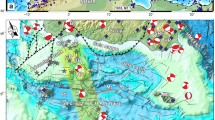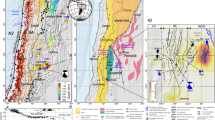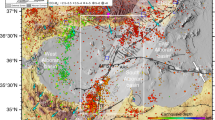Abstract
The Canterbury earthquake sequence in New Zealand was characterized by high-energy earthquakes1, a complex pattern of faulting and an extended series of aftershocks2. The mainshock occurred in September 2010, yet the largest aftershock occurred 172 days later. Beneath the Canterbury region, the Hikurangi Plateau—a large igneous province that was subducted about 100 Myr ago3—remains attached to the crust, welded to greywacke rocks that were fractured during the earthquakes. Here we use three-dimensional seismic tomographic data to investigate the role this crustal structure played in the unusual Canterbury earthquake sequence. We identify a broad, 5-km-wide region centred beneath the surface break and coincident with the depth of maximum fault slip during the mainshock that is characterized by unusually low seismic P- to S-wave velocity ratios of 1.60. Yet before the mainshock this region exhibited ratios4 of 1.71. We interpret the reduced velocity ratios as the signature of greywacke rocks that have been weakened by the fresh rupture front producing widespread cracking around the fault zone. We suggest that recovery of rock strength between the mainshock and largest aftershock could explain the long delay between the two events. In contrast to a common assumption in aftershock forecasts that crustal strength is constant, we conclude that energetic earthquakes can lead to widespread changes in the strength of Earth’s crust.
This is a preview of subscription content, access via your institution
Access options
Subscribe to this journal
Receive 12 print issues and online access
$259.00 per year
only $21.58 per issue
Buy this article
- Purchase on Springer Link
- Instant access to full article PDF
Prices may be subject to local taxes which are calculated during checkout




Similar content being viewed by others
References
Fry, B. & Gerstenberger, M. C. Large apparent stresses from the Canterbury earthquakes of 2010 and 2011. Seismol. Res. Lett. 82, 833–838 (2011).
Beavan, J., Motagh, M., Fielding, E. J., Donnelly, N. & Collett, D. Fault slip models of the 2010–2011 Canterbury, New Zealand, earthquakes from geodetic data and observations of postseismic ground deformation. NZ J. Geol. Geophys. 55, 207–221 (2012).
Reyners, M., Eberhart-Phillips, D. & Bannister, S. Tracking repeated subduction of the Hikurangi Plateau beneath New Zealand. Earth Planet. Sci. Lett. 311, 165–171 (2011).
Eberhart-Phillips, D., Reyners, M., Bannister, S., Chadwick, M. & Ellis, S. Establishing a versatile 3D seismic velocity model for New Zealand. Seismol. Res. Lett. 81, 992–1000 (2010).
Wallace, L. M., Beavan, J., McCaffrey, R., Berryman, K. & Denys, P. Balancing the plate motion budget in the South Island, New Zealand using GPS, geological and seismological data. Geophys. J. Int. 168, 332–352 (2007).
Quigley, M. et al. Surface rupture during the 2010 Mw 7.1 Darfield (Canterbury) earthquake: Implications for fault rupture dynamics and seismic-hazard analysis. Geology 40, 55–58 (2012).
Berryman, K. Geoscience as a component of response and recovery from the Canterbury earthquake sequence of 2010–2011. NZ J. Geol. Geophys. 55, 313–319 (2012).
Ristau, J. et al. The Pegasus Bay aftershock sequence of the Mw 7.1 Darfield (Canterbury) New Zealand earthquake. Geophys. J. Int. 195, 444–459 (2013).
Davy, B., Hoernle, K. & Werner, R. Hikurangi Plateau: Crustal structure, rifted formation, and Gondwana subduction history. Geochem. Geophys. Geosyst. 9, Q07004 (2008).
Taylor, B. The single largest oceanic plateau; Ontong Java–Manihiki–Hikurangi. Earth Planet. Sci. Lett. 241, 372–380 (2006).
Reyners, M. & Cowan, H. The transition from subduction to continental collision: Crustal structure in the north Canterbury region, New Zealand. Geophys. J. Int. 115, 1124–1136 (1993).
Timm, C., Hoernle, K., van den Bogaard, P, Bindeman, I. & Weaver, S. Geochemical evolution of intraplate volcanism at Banks Peninsula, New Zealand: Interaction between asthenospheric and lithospheric melts. J. Petrol. 50, 1–35 (2009).
Reyners, M. Lessons from the destructive Mw 6.3 Christchurch, New Zealand, earthquake. Seismol. Res. Lett. 82, 371–372 (2011).
Eberhart-Phillips, D. & Reyners, M. Imaging the Hikurangi Plate interface region, with improved local-earthquake tomography. Geophys. J. Int. 190, 1221–1242 (2012).
Scholz, C. H. The Mechanics of Earthquakes and Faulting 146–155 (Cambridge Univ. Press, 2002).
Scholz, C. H. The Mechanics of Earthquakes and Faulting 28–31 (Cambridge Univ. Press, 2002).
David, E. C. & Zimmerman, R. W. Pore structure model for elastic wave velocities in fluid-saturated sandstones. J. Geophys. Res. 117, B07210 (2012).
Mavko, G., Mukerji, T. & Dvorkin, J. The Rock Physics Handbook: Tools for Seismic Analysis of Porous Media 363–379 (Cambridge Univ. Press, 2009).
Li, Y-G., Vidale, J. E., Aki, K., Xu, F. & Burdette, T. Evidence of shallow fault zone strengthening after the 1992 M7.5 Landers, California, earthquake. Science 279, 217–219 (1998).
Li, Y-G., Vidale, J. E., Day, S. M., Oglesby, D. D. & Cochran, E. Postseismic fault healing on the rupture zone of the 1999 M 7.1 Hector Mine, California, earthquake. Bull. Seism. Soc. Am. 93, 854–869 (2003).
Lin, G. & Thurber, C. H. Seismic velocity variations along the rupture zone of the 1989 Loma Prieta earthquake, California. J. Geophys. Res. 117, B09301 (2012).
Wald, D. J., Helmberger, D. V. & Heaton, T. H. Rupture model of the 1989 Loma Prieta earthquake from the inversion of strong-motion and broadband teleseismic data. Bull. Seism. Soc. Am. 81, 1540–1572 (1991).
Choy, G. L., McGarr, A., Kirby, S. H. & Boatwright, J. in Earthquakes: Radiated Energy and the Physics of Faulting (eds Abercrombie, R., McGarr, A., Di Toro, G. & Kanamori, H.) 43–57 (American Geophysical Union, 2006).
Meng, L. et al. Earthquake in a maze: compressional rupture branching during the 2012 Mw 8.6 Sumatra earthquake. Science 337, 724–726 (2012).
Reyners, M., Eberhart-Phillips, D., Bannister, S. & Martin, S. The tectonic context of the destructive 2010–2011 Canterbury, New Zealand, earthquake sequence. Eos Trans. AGU (Fall Meeting Suppl.) 92, S21C-06 (2011).
Stein, S. & Liu, M. Long aftershock sequences within continents and implications for earthquake hazard assessment. Nature 462, 87–89 (2009).
Utsu, T. A statistical study of the occurrence of aftershocks. Geophys. Mag. 30, 521–605 (1961).
Perfettini, H. & Avouac, J-P. Modelling afterslip and aftershocks following the 1992 Landers earthquake. J. Geophys. Res. 112, B07409 (2007).
Michelini, A. & McEvilly, T. V. Seismological studies at Parkfield. I. Simultaneous inversion for velocity structure and hypocenters using cubic B-splines parameterization. Bull. Seism. Soc. Am. 81, 524–552 (1991).
DeMets, C., Gordon, R. G. & Argus, D. F. Geologically current plate motions. Geophys. J. Int. 181, 1–80 (2010).
Acknowledgements
This paper was improved by reviews by B. Fry and S. Ellis. GeoNet (www.geonet.org), financially supported by the New Zealand Earthquake Commission, provided the earthquake data used in the study. Research was supported by the Marsden Fund administerd by the Royal Society of New Zealand and by the Natural Hazards Research Platform of the New Zealand Ministry of Business, Employment and Innovation.
Author information
Authors and Affiliations
Contributions
M.R. helped to co-ordinate the deployment of portable seismographs after the earthquakes and led the analysis of the resulting earthquake data. D.E-P. led the tomographic inversions. S.M. assisted with earthquake analysis. M.R. wrote the manuscript, with contributions from all authors.
Corresponding author
Ethics declarations
Competing interests
The authors declare no competing financial interests.
Supplementary information
Supplementary Information
Supplementary Information (PDF 756 kb)
Rights and permissions
About this article
Cite this article
Reyners, M., Eberhart-Phillips, D. & Martin, S. Prolonged Canterbury earthquake sequence linked to widespread weakening of strong crust. Nature Geosci 7, 34–37 (2014). https://doi.org/10.1038/ngeo2013
Received:
Accepted:
Published:
Issue Date:
DOI: https://doi.org/10.1038/ngeo2013
This article is cited by
-
Aftershock Sequences of the Recent Major Earthquakes in New Zealand
Pure and Applied Geophysics (2019)



